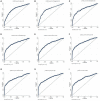Chronic kidney disease risk prediction scores assessment and development in Mexican adult population
- PMID: 36341240
- PMCID: PMC9631933
- DOI: 10.3389/fmed.2022.903090
Chronic kidney disease risk prediction scores assessment and development in Mexican adult population
Abstract
Background: Chronic kidney disease (CKD) is a major public health problem, with considerable growth in prevalence and mortality in recent years. Screening of CKD at primary care is crucial for the implementation of prevention strategies. The aims of this study are to assess CKD risk prediction scores and to develop a risk prediction score for the Mexican adult population.
Methods: Data from the Mexican National Health and Nutrition Survey 2016 was utilized and 3463 participants ≥ 20 years old were included. Reduced renal function with Glomerular filtration rate and/or the presence of albuminuria was defined as CKD. Multiple logistic regression models were performed for the creation of a training and validation model. Additionally, several models were validated in our Mexican population.
Results: The developed training model included sex, age, body mass index, fast plasma glucose, systolic blood pressure, and triglycerides, as did the validation model. The area under the curve (AUC) was 0.78 (95% CI: 0.72, 0.79) for training model, and 0.76 (95% CI: 0.71, 0.80) in validation model for Mexican adult population. Age, female gender, presence of diabetes and hypertension, elevated systolic and diastolic blood pressure, serum and urinary creatinine, and higher HbA1c were significantly associated with the prevalent chronic kidney disease. Previous CKD risk predictive models were evaluated with a representative sample of the Mexican adult population, their AUC was between 0.61 and 0.78.
Conclusion: The designed CKD risk predictive model satisfactorily predicts using simple and common variables in primary medical care. This model could have multiple benefits; such as, the identification of the population at risk, and prevention of CKD.
Keywords: Mexican; chronic kidney disease; prediction; risk score; validation.
Copyright © 2022 Colli, González-Rocha, Canales, Hernández-Alcáraz, Pedroza, Pérez-Chan, Barquera and Denova-Gutierrez.
Conflict of interest statement
The authors declare that the research was conducted in the absence of any commercial or financial relationships that could be construed as a potential conflict of interest.
Figures


References
-
- Agudelo-Botero M, Valdez-Ortiz R, Giraldo-Rodríguez L, González-Robledo MC, Mino-León D, Rosales-Herrera MF, et al. Overview of the burden of chronic kidney disease in Mexico: secondary data analysis based on the global burden of disease study 2017. BMJ Open. (2020) 10:e035285. 10.1136/bmjopen-2019-035285 - DOI - PMC - PubMed
-
- Gómez-Dantés H, Fullman N, Lamadrid-Figueroa H, Cahuana-Hurtado L, Darney B, Avila-Burgos L, et al. Dissonant health transition in the states of Mexico, 1990–2013: a systematic analysis for the global burden of disease study 2013. Lancet. (2016) 388:2386–402. 10.1016/S0140-6736(16)31773-1 - DOI - PubMed
LinkOut - more resources
Full Text Sources

